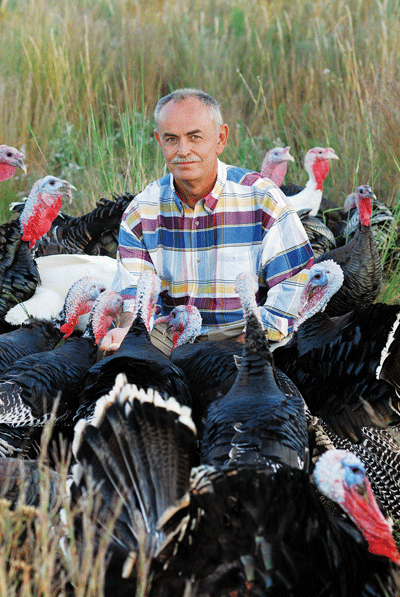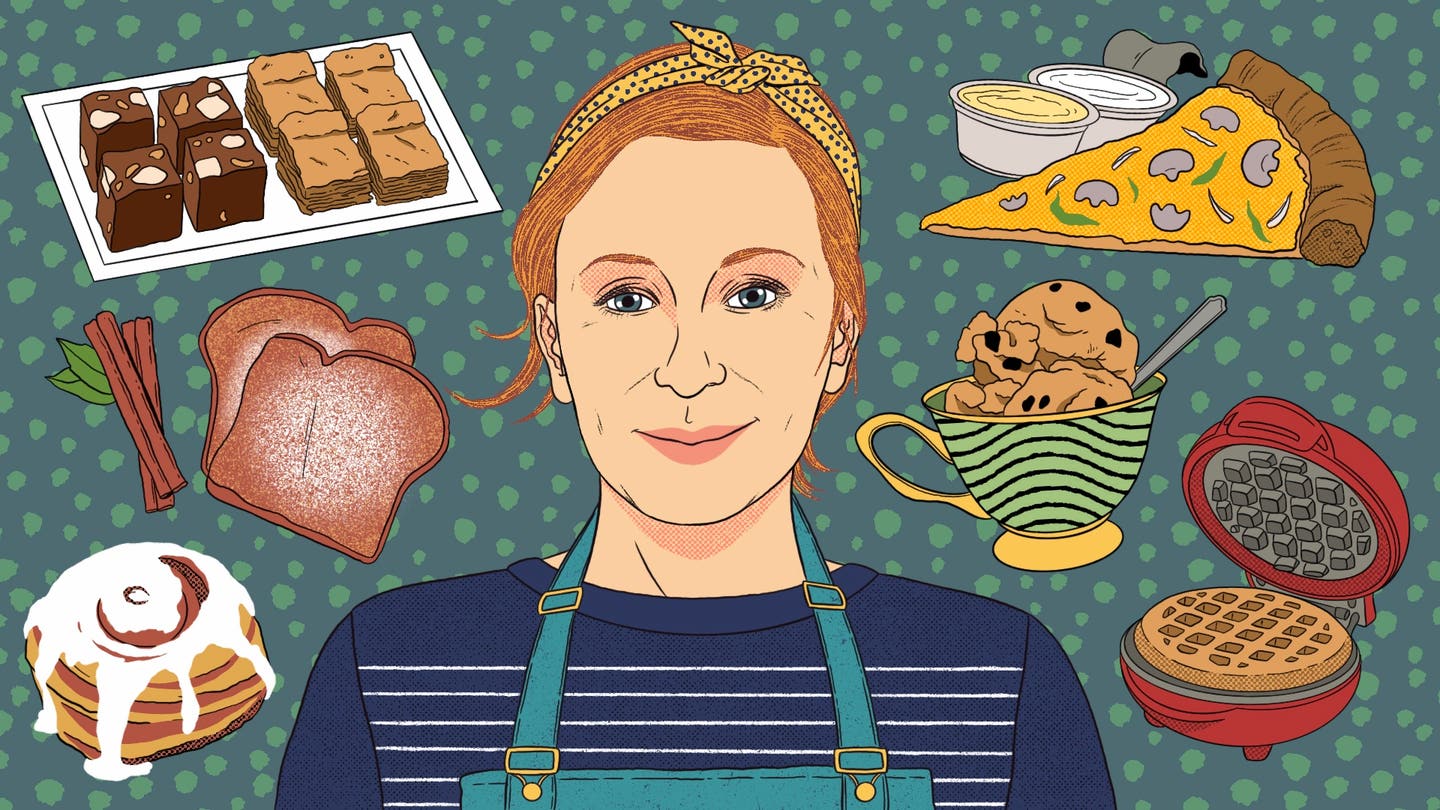
Rare Breed
Beyond the town of Lindsborg, with its church steeples and 2,000 or so houses, the Kansas prairie is a flat forever. There's nothing to absorb wind or sound. The whinny of gears in a pickup; the bullish snort of a combine harvester turning frosty dirt—the noises of a winter afternoon seemed bigger than anything mortal. Standing in a field on Frank Reese Jr.'s farm outside town as the shadows grew longer, I felt truly alone.
I pictured Reese, a poultry breeder who was born near here, shepherding his turkeys across this same, endless horizon as a boy and wondered whether he too had felt alone. From an early age, he had the job of ushering birds on his family's farm from the barn to the open range so that they could peck for insects. He took to the role, and to the birds. When the other children in his first-grade class wrote adoring sonnets to their cats and dogs, Reese crafted a personal essay titled "Me and My Turkeys."
He was surprised by the looks he got. In his young mind, love was love, and he has no memory of ever not loving turkeys. That is the only way he can explain having devoted his life to preserving the traditional American breeds that were once common on dinner tables across the country. After all, though Reese is a perfectly good cook, he's not the sort of fanatic who'd spend decades chasing the Platonic ideal of an ingredient. He also doesn't seem like the type of person who'd take up the banner against industrial farming.
In fact, Reese, who is 61 years old, would prefer to spend his evenings reading antique poultry magazines or the spiritual writings of Saint Augustine and Saint Teresa. He is solidly built and speaks in measured tones. In his well-pressed flannel shirt, he looks as if he might have stepped off a page of the 1954 Sears, Roebuck catalogue.
And yet, to food lovers, animal lovers, and many family farmers, this fourth-generation farmer from Kansas is more than just a turkey breeder with old-fashioned ways. He is a saint. Reese is the man who saved American poultry.
From the outside, the farmhouse at the Good Shepherd Turkey Ranch, which is what Reese calls his farm, looks like a monument to a vanished way of life. Set on a corner of the 160-acre spread, the three-story home has Victorian trim and a fresh coat of white paint. It is framed by two red barns and a venerable elm tree, the kind you'd expect to see a swing hanging from. A pie should be cooling on the sill of the kitchen window. Kids should be chasing around the yard.
But Reese is a bachelor. Instead of family portraits and Norman Rockwell prints, turkey-related art hangs on the walls alongside his collection of religious art and blue ribbons from poultry shows. The house is well tended—Reese restored the white pine woodwork and ordered burgundy-colored Victorian-style wallpaper from the designer wallpaper company Bradbury & Bradbury for the dining room and sitting room—but the scent of diesel fuel and turkey coop from Reese's work clothes laces the air. Feed catalogues, fan letters, tax forms, utility bills, and photographs of turkeys are arranged in neat piles on the dining-room table. I'd spent the day visiting the farm with Reese, and he'd invited me in from the cold. The house was utterly quiet but for the sound of the farmer riffling through the papers on the table. Finally, finding what he was after, he waved a black-and-white portrait of a handsome Bronze turkey. "Charlie!" he exclaimed.
"Out of a thousand turkeys," Reese said, "there is always one who wants to be with you all the time. Charlie was my first. When I was a kid, the neighbor's dog got his tail. The vet took one look and said, 'You better just butcher him.' I went nuts and said, 'You fix him!' So he sewed his tail back on, and Charlie and I hung out for the next ten years."
For decades, Reese assumed that he'd gotten so friendly with turkeys when he was a kid merely to make the best of a frustrating situation. "I was the youngest and too little to drive the tractor or handle the cattle or pigs," he said, "so I got sent to the poultry house." Eventually, though, he came to the awareness that there had to be more to it than that. "My father once said that he took me to the state fair when I was three and that all I wanted to do was drag him through the turkey exhibits," Reese told me. "So maybe I was just born this way."
Until he'd grown enough to manage turkeys on his own, Reese showed chickens. He took his first blue ribbon at the Saline County Fair when he was eight years old and won every year for the next decade. Starting at the age of ten, he showed turkeys too.
"I got beat a lot," he said. "Back then, there was no kids' division, and I was up there showing with all the old, legendary turkey breeders: Norman Kardosh and his Narragansetts, Sadie Lloyd and her Bourbon Reds, Cecil Moore and his Bronzes." The older turkey breeders may have taken home the blue ribbons, but they also took note of Reese's talent. These farmers and enthusiasts had spent lifetimes preserving American barnyard breeds, some of whose bloodlines could be traced to the 1890s. Until Frank Reese appeared, none of those breeders had anointed an heir to continue their legacy. Each knew the clock was ticking.
Growing up, Reese was never more in his element than he was at poultry shows. These bustling events, which took place across rural America throughout the 20th century (and still do, in some areas), culminated in big annual national competitions, where farmers and hobbyists displayed prized birds that they'd bred for hardiness, meat quality, reproductive prowess, and physical beauty. Held in vast exhibition halls, the juried contests were similar to dog shows, a Best in Show milieu in which hair dryers were aimed at feathers rather than fur. "If you won the national show, you were set because everybody wanted to buy your birds," said Reese.
The shows were also where older breeders mentored potential successors. "They taught me the breed history," Reese remembered. "They had me sitting on the ground with my standards book, studying each bird." Reese was talking about Standard of Perfection, a guide published by the American Poultry Association that recognizes eight distinct varieties of turkey that are considered to be the purest farm breeds and describes the ideal physical characteristics of each one. The book, first published in 1874, harks back to an era when the differences between common breeds of chickens and turkeys were as dramatic as the differences between, say, a Great Dane and a Dachshund. These varieties were raised for different uses: big roasters for Sunday dinners, tough and flavorful stewers for soup, plump-legged fryers, and so on.
Norman Kardosh, a breeder from Alton, Kansas, was Reese's most influential teacher. "Norman taught me about the importance of fine breeding, how it ensures the survival of the best bloodlines and how that, in turn, ensures biodiversity among the species. Without those two things, any creature is doomed to extinction."
At some point in the late 1970s, after earning a nursing degree and finishing a stint in the army in Texas, Reese realized that standard bred birds—as the types of poultry recognized in Standard of Perfection are called—were in trouble. He was raising turkeys at his home south of San Antonio and competing on the side. "I'd always competed against 50 to 100 birds at every show. Suddenly it was just me," he recalled.
American farmers just weren't raising standard bred birds anymore, at least not in significant numbers. "The commercial industry had developed a couple varieties that cost less to feed, fattened up faster, and sold well, and farmers raised these to the exclusion of all others," Reese explained to me. "This means that one flu could wipe out every bird in this country." To make matters worse, he said, commercial birds—a broad-breasted white variety developed in the 1950s—all tend to taste the same. "They have no flavor! No individuality!" he lamented.
Reese began expanding his flock. Meanwhile, he worked as a nurse at a hospital in San Antonio and eked out additional money by taking odd jobs and even modeling. In his early 30s, Reese looked every inch the Marlboro Man, whom he once portrayed in an advertising campaign.
Texas was fun, said Reese, "but it was no place to raise a turkey." So, in 1989, he moved back to Kansas, bought a farm outside Lindsborg that he called Good Shepherd Turkey Ranch, and ramped up his breeding program. He was more worried than ever about American poultry. "The bloodlines were dying out. Norman didn't want to believe me," Reese recalled. "He was in his late 70s, but he got in his truck and went looking for his birds. He went to every farm he'd sold to, and he didn't find one Norman Kardosh Narragansett." Reese's other mentors were beginning to pass away. "Norman was the last to go," Reese said. "I promised him that I would not let these birds die off the face of the Earth."
By 2002, Reese had increased the national population of standard bred turkeys to such an extent that he was able to sell to some restaurants and individuals. "The only way to save these birds is to get people to eat them," he said. Reese created a cooperative of several farmers in Kansas and sold 800 heritage turkeys—as the farmers branded their standard bred birds—that first year. Two years later, Reese took on a business partner, a young poultry farmer named Brian Anselmo, whom Reese considered to be the next heir to the old-breed poultry legacy. In 2007, the number of farmers in the Good Shepherd co-op grew to a dozen; they sold 10,000 old-breed turkeys that Thanksgiving. It wasn't much compared with the 46 million industrially raised turkeys sold during that holiday each year, but it was a milestone nonetheless.
In 2008, Anselmo died suddenly of complications of asthma at the age of 28. Reese, recognized by then as the premier source of old-breed birds in the nation, became even more focused on selling his breeding stock. "I'm all these birds have now," Reese said. Nowadays, he's pouring his energy into plans for the Standard Bred Poultry Institute, a place where farmers will learn how to breed, raise, preserve, and cook these birds. He is building the facility, using his own savings and, he hopes, donor money, on the ridge just beyond his barns. "I'm leaving it all to them," Reese said.
We'd been sitting in his dining room for a long while. Outside, the wind was keening around the house. Reese pushed back from the table, and I followed him as he walked to the kitchen, zipped a barn jacket over his flannel shirt, pulled on a stocking cap, and walked out his back door.
We headed toward the pasture next to the larger of the two red barns. There, under a darkening sky, hundreds of turkeys were already crowding at the fence, strutting excitedly, puffing their feathers, and craning their wobbly-skinned necks. The birds mobbed Reese as he pushed through the gate. At the center of this shiny, feathery universe, Reese chattered and scolded. Bending down, he scooped up a huge Bronze and cradled it in the crook of his arm.
"This is Norman," he said, beaming. The bird had bright eyes and copper-colored feathers with black edges. He put Norman down, and the animal spread its lush tail feathers in an impressive rainbow. "Isn't he something?" said Reese. "We've been hanging out for a few years. Norman isn't going anywhere. Norman's staying right here."
Keep Reading
Continue to Next Story










